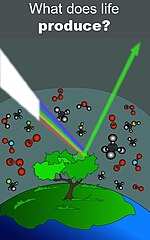
MERMOZ (also, MERMOZ project and Monitoring planEtary suRfaces with Modern pOlarimetric characteriZation) is an astrobiology project designed to remotely detect biosignatures of life. Detection is based on molecular homochirality, a characteristic property of the biochemicals of life. The aim of the project is to remotely identify and characterize life on the planet Earth from space, and to extend this technology to other solar system bodies and exoplanets. The project began in 2018, and is a collaboration of the University of Bern, University of Leiden and Delft University of Technology.
According to a member of the research team, “When light is reflected by biological matter, a part of the light’s electromagnetic waves will travel in either clockwise or counterclockwise spirals ... This phenomenon is called circular polarization and is caused by the biological matter’s homochirality.” These unique spirals of light indicate living materials; whereas, non-living materials do not reflect such unique spirals of light, according to the researchers.
The research team conducted feasibility studies, using a newly designed detection instrument, based on circular spectropolarimetry, and named FlyPol+ (an upgrade from the original FlyPol), by flying in a helicopter at an altitude of 2 km (1.2 mi) and velocity of 70 km/h (43 mph) for 25 minutes. The results were successful in remotely detecting living material, and quickly (within seconds) distinguishing living material from non-living material. The researchers concluded: "Circular spectropolarimetry can be a powerful technique to detect life beyond Earth, and we emphasize the potential of utilizing circular spectropolarimetry as a remote sensing tool to characterize and monitor in detail the vegetation physiology and terrain features of Earth itself."
The researchers next expect to scan the Earth from the International Space Station (ISS) with their detection instruments. One consequence of further successful studies is a possible pathfinder space mission, scheduled to launch in 2024.
See also
References
- ^ Cofield, Calla; Chou, Felicia (25 June 2018). "NASA Asks: Will We Know Life When We See It?". NASA. Retrieved 21 June 2021.
- ^ "UCR team among scientists developing guidebook for finding life beyond earth – Major series of review articles outlines past, present, and future of searching for life on other planets". University of California, Riverside. 25 June 2018. Retrieved 21 June 2021.
- ^ Patty, C.H.L.; et al. (2021). "Biosignatures of the Earth I. Airborne spectropolarimetric detection of photosynthetic life". Astronomy & Astrophysics. A68: 651. arXiv:2106.00493. Bibcode:2021A&A...651A..68P. doi:10.1051/0004-6361/202140845. S2CID 235265876. Retrieved 21 June 2021.
- ^ Patty, C.H. Luca; et al. (1 June 2021). "Biosignatures of the Earth". Astronomy & Astrophysics. 651: A68. arXiv:2106.00493. Bibcode:2021A&A...651A..68P. doi:10.1051/0004-6361/202140845. S2CID 235265876.
- ^ University of Bern (20 June 2021). "Scientists Use New Technology to Detect Signatures of Life Remotely". SciTechDaily.com. Retrieved 21 June 2021.
- ^ "Scientists Detect Signatures Of Life Remotely". Astrobiology.com. 20 June 2021. Retrieved 21 June 2021.
- ^ "SAINT-EX ― Search and characterisation of exoplanets - MERMOZ description". Saintex.Unibe.ch. 2021. Retrieved 21 June 2021.
- ^ Hanks, Micah (22 June 2021). "Scientists Detect Signs Of Life At A Distance Using Remote Sensing". TheDebrief.org. Retrieved 22 June 2021.
- ^ Kühn, J.; et al. (13 December 2020). "Monitoring the Earth's diverse environments with full-Stokes spectro-polarimetry: The MERMOZ project". In Evans, Christopher J; Bryant, Julia J; Motohara, Kentaro (eds.). Ground-based and Airborne Instrumentation for Astronomy VIII. SPIE. 114479L. doi:10.1117/12.2576310. ISBN 9781510636811. S2CID 230540533. Retrieved 22 June 2021.
- ^ Kühn, Jonas; Patty, Lucas (2020). "Project 4.1: Characterisation of bio-markers using spectro-polarimetry". National Centre of Competence in Research PlanetS. Retrieved 21 June 2021.
| Extraterrestrial life | |||||||
|---|---|---|---|---|---|---|---|
| Events and objects |
| ||||||
| Signals of interest |
| ||||||
| Life in the Universe | |||||||
| Planetary habitability |
| ||||||
| Space missions |
| ||||||
| Interstellar communication |
| ||||||
| Types of alleged extraterrestrial beings | |||||||
| Hypotheses | |||||||
| Fermi paradox solutions | |||||||
| Related topics |
| ||||||
This spacecraft or satellite related article is a stub. You can help Misplaced Pages by expanding it. |